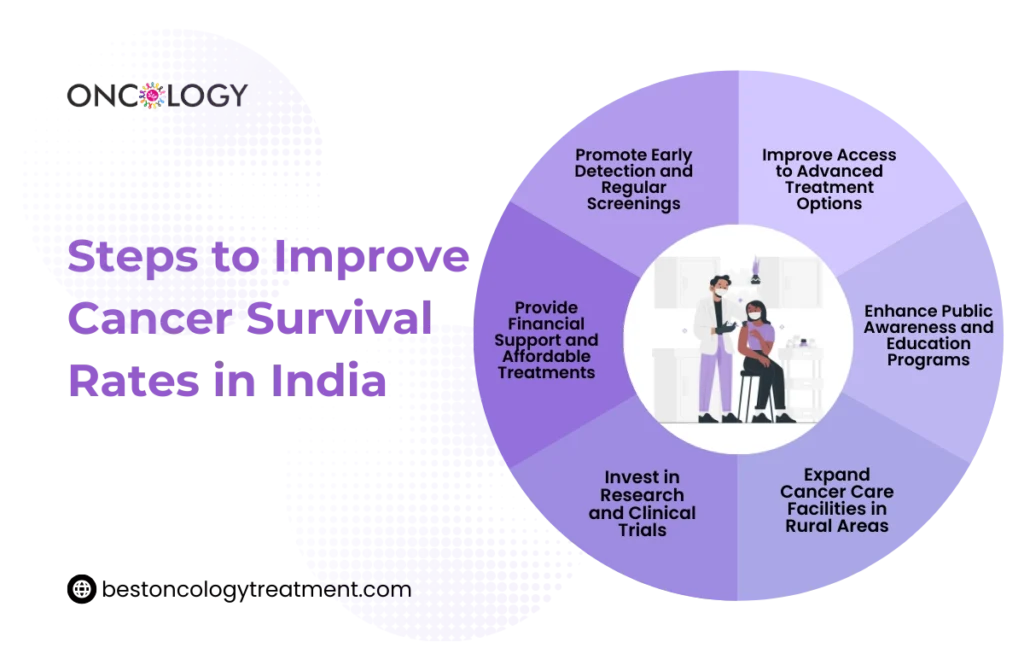The cancer death rate in India has become a growing concern as cancer cases continue to rise. With over a million new cancer cases diagnosed each year, understanding the factors that contribute to this alarming figure is crucial. The good news is that improvements in medical technology and treatment approaches are making a difference. However, more work needs to be done to further lower the cancer death rate in India and enhance the cancer survival rate in India.
Overview of Cancer Death Rate in India
India has seen a steady rise in cancer-related deaths, with lifestyle changes, environmental factors, and late-stage diagnosis being key contributors. The current cancer death rate in India is worrisome, particularly in rural areas where access to healthcare is limited. According to recent statistics, cancer accounted for nearly 8% of all deaths in India. Despite advancements in treatment, the rate of death from cancer remains high, and more efforts are needed to bring about substantial change.
Factors Affecting Cancer Death Rate
Several factors contribute to the high cancer death rate in India, including late diagnosis, lack of awareness, limited access to treatment, and the costs associated with cancer care. Early detection remains one of the most effective ways to improve the cancer survival rate in India, but this can only be achieved through widespread awareness and access to proper screening facilities.
Moreover, while urban centers have access to advanced cancer treatments, rural regions still face significant challenges in terms of infrastructure and resources. Addressing this urban-rural disparity is vital to lowering the cancer death rate in India and improving overall outcomes for patients across the country.
Improving Cancer Survival Rate in India
Efforts to enhance the cancer survival rate in India are already underway, with advancements in early detection techniques, targeted therapies, and immunotherapies. Hospitals and specialized cancer treatment centers are working to improve the cancer recovery rate in India by providing patients with better access to cutting-edge treatment options. One of the most significant factors in increasing the survival rate is the development of personalized treatment plans that cater to each patient’s specific condition and stage of cancer.
Increased investment in research and development has also contributed to the improvement in treatment outcomes. With more clinical trials and research focused on understanding cancer at a molecular level, the potential for improving cancer survival rates has never been greater. This scientific progress is critical in lowering the cancer death rate in India.

Current Scenario of Cancer Death Rate in India
In recent years, the cancer death rate in India has shown alarming trends. According to recent statistics, cancer is now the second leading cause of death in the country, accounting for a substantial mortality burden. The incidence of various types of cancers has been rising, contributing to higher mortality rates across different demographics and regions.
Factors Influencing Cancer Death Rate
Several factors contribute to the cancer death rate in India, including:
- Late Diagnosis: A significant number of cancer cases are diagnosed at advanced stages, reducing treatment efficacy and survival rates.
- Limited Access to Healthcare: Many regions face challenges in accessing timely and quality cancer care, impacting treatment outcomes.
- Lifestyle Factors: Increasing prevalence of risk factors such as tobacco use, unhealthy diet, and sedentary lifestyles contribute to rising cancer incidences and mortality rates.
Efforts Towards Improving Cancer Survival Rate in India
Efforts to improve cancer survival rates in India are multifaceted:
- Enhanced Screening Programs: Increasing awareness and access to screening programs can facilitate early detection and intervention, improving survival rates.
- Advancements in Treatment: Adoption of advanced treatment modalities including targeted therapies and immunotherapy is improving outcomes for cancer patients.
- Healthcare Infrastructure Development: Investments in healthcare infrastructure and facilities specialized in oncology are crucial for providing comprehensive cancer care.
Challenges in Cancer Recovery Rate in India
Cancer recovery rates in India face several challenges, impacting patient outcomes and overall healthcare quality. Key challenges include:
- Late Diagnosis: Many cancers are diagnosed at advanced stages due to lack of awareness and limited access to early screening facilities.
- Limited Access to Healthcare: Rural areas often lack adequate healthcare infrastructure, making it difficult for patients to receive timely and effective treatment.
- Financial Constraints: High treatment costs and inadequate insurance coverage result in financial burden, preventing many patients from accessing necessary care.
- Shortage of Oncology Specialists: There is a significant shortage of trained oncologists and specialized cancer care centers, particularly in rural and semi-urban regions.
- Inconsistent Treatment Quality: Variability in the quality of care across different hospitals and regions affects treatment outcomes.
- Cultural and Social Barriers: Stigma associated with cancer and traditional beliefs can lead to delays in seeking treatment or adherence to medical advice.
- Lack of Awareness: Limited public knowledge about cancer symptoms, risk factors, and the importance of early detection contributes to late diagnoses.
- Insufficient Palliative Care: Limited availability of palliative care services affects the quality of life for patients with advanced cancer.
- Research and Data Gaps: Inadequate research infrastructure and data collection hinder the development of effective cancer treatment and prevention strategies.
Addressing these challenges requires a multifaceted approach, including improving healthcare infrastructure, increasing public awareness, enhancing financial support systems, and expanding the training of healthcare professionals in oncology.
Mortality rates
Mortality rates for cancer-related deaths reflect the number of individuals who succumb to cancer within a given population over a specific period. In India, these rates vary significantly across different types of cancer and regions due to various factors:
- Type and Stage of Cancer: The mortality rate varies depending on the type of cancer and the stage at which it is diagnosed. Cancers detected at advanced stages generally have higher mortality rates due to limited treatment options and poorer prognosis.
- Access to Healthcare: Disparities in healthcare access influence mortality rates. Rural areas often face challenges in accessing timely diagnosis, treatment facilities, and specialized oncology care, leading to higher mortality rates compared to urban areas.
- Awareness and Early Detection: Lack of awareness about cancer symptoms and preventive measures can delay diagnosis, resulting in late-stage presentations and higher mortality rates.
- Treatment Availability and Quality: The availability of effective treatment modalities, including surgery, chemotherapy treatment, and radiotherapy, significantly impacts mortality rates. Limited access to these treatments can compromise outcomes.
- Socioeconomic Factors: Socioeconomic status affects mortality rates, with lower-income groups facing greater barriers to accessing quality healthcare and experiencing higher mortality rates.
Efforts to reduce cancer-related mortality rates in India include improving healthcare infrastructure, increasing awareness about early detection, enhancing treatment accessibility, and promoting healthier lifestyles. These measures aim to mitigate the impact of cancer and improve survival outcomes across the population.
Possible Causes of High Incidence
The high incidence of cancer in India can be attributed to several interrelated factors:
- Lifestyle Choices: Increasing adoption of unhealthy lifestyles such as tobacco use, alcohol consumption, and sedentary habits contribute significantly to cancer risk.
- Environmental Factors: Exposure to environmental pollutants, including air and water pollution, as well as occupational hazards in industries like mining and manufacturing, can increase cancer risk.
- Genetic Predisposition: Certain genetic mutations and family history of cancer can predispose individuals to higher cancer incidence.
- Delayed Diagnosis: Limited awareness about early symptoms and hesitation in seeking medical help often lead to late-stage diagnoses, reducing treatment efficacy.
- Inadequate Healthcare Infrastructure: Disparities in access to quality healthcare services, especially in rural areas, result in delayed or suboptimal treatment.
- Nutritional Factors: Changing dietary patterns, with increased consumption of processed foods and reduced intake of fruits and vegetables, may contribute to cancer risk.
Addressing these factors requires a multifaceted approach involving public health education, policy interventions to reduce environmental exposures, improvements in healthcare accessibility, and promotion of healthier lifestyles. Efforts towards early detection through screening programs and enhancing treatment facilities are also crucial in mitigating the burden of cancer in India.
How India Can Further Improve Cancer Recovery Rates
The cancer recovery rate in India is closely tied to early diagnosis, timely treatment, and access to the latest medical advancements. To further improve cancer outcomes, India must focus on building a healthcare infrastructure that supports these key elements. Government initiatives aimed at providing affordable healthcare, especially for cancer patients, will play a significant role in improving the cancer recovery rate in India.
Additionally, ongoing public awareness campaigns can help educate people about cancer risk factors and the importance of regular screenings. By catching the disease in its early stages, patients have a much better chance of achieving long-term remission, significantly improving the overall cancer survival rate in India.
The Road Ahead: Improving Cancer Survival Rates in India
India’s battle against cancer requires a multi-faceted approach, combining prevention, early detection, and access to top-tier treatment options. While progress has been made, particularly in urban areas, there is still a long way to go in reducing the cancer death rate in India. With the right strategies in place, the country’s healthcare system can continue to evolve and provide better care for cancer patients.
Improvements in medical technology and innovative treatment approaches are key to improving cancer survival rates and ultimately lowering mortality rates. In addition, patient education, affordable treatment, and more robust healthcare policies will all contribute to a future where more lives are saved.
Conclusion
The cancer death rate in India remains a critical public health issue. However, with focused efforts on early detection, improving access to quality healthcare, and investing in advanced treatment methods, there is hope for better outcomes. As India continues to improve its healthcare infrastructure and raise awareness about cancer, we can expect to see an improvement in both the cancer survival rate in India and the cancer recovery rate in India.




